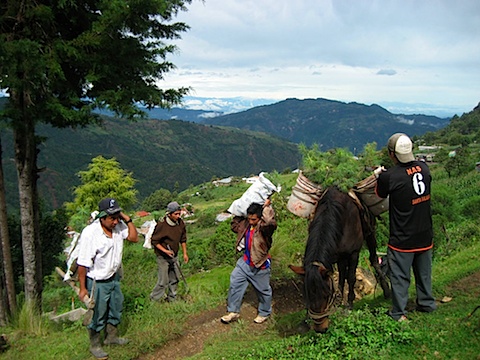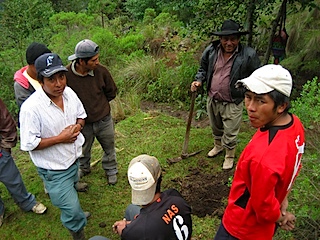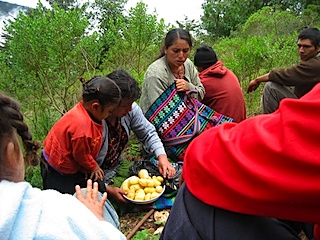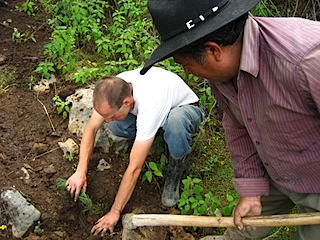Looking around my house in these last remaining days, my eyes fell upon The Stove. I can say pretty honestly that it has become one of my favorite things in our home, and I will miss it dearly. In the half year before we had it, we were suffering daily from the nonstop 40-degree weather and misty rain. Now, in contrast, we can actually go out into that weather comfortably, knowing there will be relief when we come back inside. Before, our clothes took up to two weeks to dry; now it’s two days. But the biggest benefit is psychological. A cheery, crackling fire on a cold night is a place you can gather, rub your hands together, and drink cocoa. Every guest we’ve ever had, both Mayan and Gringo, has marveled at how it transforms our tiny wooden shack into a comfortable resting place.
This marvel of fine living comes with a price, though. Our stove burns a tarea or two of firewood a month (about half a chord?), in a country where deforestation is already a serious concern, and 99% of people cook with firewood. We give lectures about how the loss of forests encourages landslides, global warming, and degradation of freshwater springs, so we’d be hypocrites if we didn’t do something about it.
“I think we need to plant some trees,” Emily said a few months ago. We talked it over, and realized that was no other responsible thing to do. And by “some” trees, we were talking about several hundred, bought with our own money, as an act of contrition.
But where would we plant them? It would be good double-duty to plant them on some of Nas’s land, thanking his family as well as the Earth, but we didn’t know where all of his property was located, or if he’d even accept that sort of gift. After the sheep poisoning incident, he’s refused any sort of aid we’ve ever offered him, thinking it would cause envy in his neighbors and make life difficult for his entire family. But a few weeks later, I found myself sitting at the edge of the field, chatting with him as the sun went down, and saw my opportunity.
“Nas, we’ve been thinking that we need to plant some trees to replace all that we’ve burned in our time here,” I began. “Would you be interested in helping us? We’d like to plant them on your property, if you have the space. This isn’t a project from Peace Corps or some agency; this is a personal gift from Emily and me.”
He stared off into the field for a while, not answering. Then he nodded. “I think I’d like that. How many trees were you thinking?”
“About five hundred. I don’t know how many cuerdas of land you’d need for that many, though.”
He looked up at me, with a twinkle in his eye. That’s when I found out that he’d done reforestation projects long ago, and knows exactly how many trees you can plant in a cuerda of land.
In the next few days, we made plans. Nas spoke with his family a few times, and they decided they’d plant the trees on his land, as well as adjacent properties owned by Abel (his son-in-law) and Masha (his second oldest daughter). By accident, I’d discovered a vivero (nursery) a few weeks ago, right next to the new high school construction site. I chatted with the nurseryman, and found which seedlings he was selling, how much they cost, and how to get them delivered. But the luckiest accident I had was mentioning the idea to my boss Basilio during the COS conference.
“You know, before I was the director of the Healthy Homes program for the Peace Corps, I ran the now-defunct Reforestation program,” he said with a huge smile. Duh, of course! Mike Bosio (who comments often on this blog) worked as Peace Corps volunteer with Basilio in the 70s for that very program. Basilio was really excited about our idea, and gave me all sorts of pointers on what type of trees I should and shouldn’t plant, as well as offering to come talk to Nas next time he was in Santa Eulalia. He was particularly excited about us planting aliso, which I later discovered to be the alder tree. It’s a fast growing hardwood that thrives in the regional conditions that we have, whose wood can be used for both construction and burning, and they regrow when cut down, so they don’t need to be replanted.
After much negotiation, we ended up buying 400 white pine seedlings. Everyone here likes white pine, they are cost effective, and they grow well in our climate. I wanted to plant half in aliso, but the nursery was out of them. “Don’t worry,” Nas said. “I planted aliso last time, and there are still a lot growing up there on the adjacent property.” We finalized the details with the nursery’s office manager, and I took out my money.
“Oh, you’re going to pay?” she said, getting out a receipt book. That’s when I found out there are actually two ways to get the trees. The second way is to have a government technician come out to your land, survey it, and they give you the trees for free- with the provision that you can’t cut them down for 5 years. Neat idea, but we didn’t have time to wait on a government guy that could take months to show up. Better to just pay now, and start tomorrow.
“OK,” she said. “We’ll send the technician by about this time next year, then, so he can check on the trees before he pays the landowner the annual incentive money.” WHAT? Turns out under the pay-as-you-go option, the government has a cash incentive program that rebates money to landowners if they maintain the trees. Sweet! Not only are we repaying our debt to nature and leaving trees for Nas’s family, but they will get cash in their hands for the next half decade as well.
 The fateful day finally came, on the last full day in our village. Talk about putting something off until the last minute! We got up early, and went down to Nas’s son’s house, where we’d stored the seedlings that had been delivered to the village the day before. “I got some muchachos to help,” Nas said as he hoisted a bucket full of baby trees onto his horse. I knew all of the guys except for one, a half-dozen friends and relatives who each picked up their own 50-pound sack of seedlings to carry up the mountain. Between the horse and everyone carrying, we had about 250 seedlings this trip.
The fateful day finally came, on the last full day in our village. Talk about putting something off until the last minute! We got up early, and went down to Nas’s son’s house, where we’d stored the seedlings that had been delivered to the village the day before. “I got some muchachos to help,” Nas said as he hoisted a bucket full of baby trees onto his horse. I knew all of the guys except for one, a half-dozen friends and relatives who each picked up their own 50-pound sack of seedlings to carry up the mountain. Between the horse and everyone carrying, we had about 250 seedlings this trip.
After about a half hour of hiking, we arrived at the land. It was a wide swath of rocky scrub and sheep pasture, bordered on two sides by immature woodland. “I planted those woods years ago,” Nas said as he took the picks and machetes off of the horse. I looked out over the valley that we’ve called home for the last two years, sighing deeply. What a beautiful day. What a beautiful way to spend my last day in the village.
 Galindo disappeared with a machete and returned with a few long, slender canes he’d cut from the underbrush. Nas measured them to three barrras, the spacing we were going to use between the trees, and everyone gathered around him as he gave a lesson on how to plant seedlings. Then, we broke up into work groups and started planting a forest: one person with pick and measuring stick, the other with a bucket of trees. We continued row by row, working our way down the hill.
Galindo disappeared with a machete and returned with a few long, slender canes he’d cut from the underbrush. Nas measured them to three barrras, the spacing we were going to use between the trees, and everyone gathered around him as he gave a lesson on how to plant seedlings. Then, we broke up into work groups and started planting a forest: one person with pick and measuring stick, the other with a bucket of trees. We continued row by row, working our way down the hill.
“Where we plant this row of trees is very important,” Nas said as he pointed out a red painted rock. “This is the border between two inheritances. Right now, the properties have the same owner, me, but if we plant trees right on the line, it will cause a big fight over the firewood two generations from now.” It amazes me that despite their general lack of preplanning for anything, people here sometimes anticipate subtle social conflicts far in the future and work hard to avoid them. If only they could plan like that for latrines and concrete floors! Galindo waved from atop an alder tree a few hundred yards away, and they sighted between the two markers to keep the plantings straight.
 Around noon, Masha and Gela came up the hill with lunch buckets on their heads and Delmi and Michelle in tow. Boiled potatoes, chili peppers, and coffee for everyone! It was a lot tastier than it sounds, and I ate a half dozen potatoes as Delmi sat on my lap. From this vantage point, I could actually see the roof of our tiny house, nestled in the valley directly below us. Maybe these trees would one day keep a landslide from wiping out Nas’s entire family?
Around noon, Masha and Gela came up the hill with lunch buckets on their heads and Delmi and Michelle in tow. Boiled potatoes, chili peppers, and coffee for everyone! It was a lot tastier than it sounds, and I ate a half dozen potatoes as Delmi sat on my lap. From this vantage point, I could actually see the roof of our tiny house, nestled in the valley directly below us. Maybe these trees would one day keep a landslide from wiping out Nas’s entire family?
“This is the Jaime Forest!” one of them joked. They all smiled and laughed.
“Actually, it was Emily’s idea,” I said. “You should call it the Fanjoy Forest.” Some confusion ensued, as almost no one here knows our last name, since they don’t have family names in the same sense that we do, and never use them. I explained that unlike the custom here, Americans often share a family name between married couples, and ours is Fanjoy, and that name is passed down from my father.
“Fanjoy Forest it is!” they beamed, thinking it a great idea. “We will call it that, and our children will call it that.” What they don’t know is that calling it the Fanjoy Forest also pays homage to my father and my father’s father, who were both avid outdoorsmen, men of woods and water. I can’t think of anything either of them would like more than to have a stand of trees named after them.
 With lunch wrapped up, we set back to work planting more trees. In the next few hours, our total for the day climbed to 250 saplings. “We’re out of trees!” Nas smiled. “We’ll come back tomorrow and plant the remaining 150 without you. We know you have a very important journey to make.” Empty buckets, picks, machetes, and hoes were all strapped onto the horse for the trip back down the hill.
With lunch wrapped up, we set back to work planting more trees. In the next few hours, our total for the day climbed to 250 saplings. “We’re out of trees!” Nas smiled. “We’ll come back tomorrow and plant the remaining 150 without you. We know you have a very important journey to make.” Empty buckets, picks, machetes, and hoes were all strapped onto the horse for the trip back down the hill.
About that time, I heard a yelp, and turned around to see that a full-on mud fight was under way. Abel, Lucas, and a teenager who’s name I think is Ixtup were slinging clods of dirt at each other and laughing uncontrollably. They closed, and as Abel and Lucas struggled to make each other eat dirt pies, Ixtup jammed a fistful of mud down Lucas’s shirt. In seconds, it degenerated into a mudwrestling match, ending in a cartoon-like ball of bodies, arms, and legs going rolling down the mountainside, flattening bushes as it went. It disintegrated about 50 feet downhill, everyone laughing so hard they were almost crying.
I sat amongst the fresh seedlings and looked out to the west, where the mountains of Mexico fade away towards the horizon in layers of steel grey, and watched as puffy clouds rolled into our little valley to the sound of laughing Mayans. Definitely, my last day in the village was one of the best of my entire Peace Corps service.